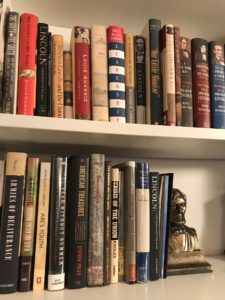 Even when I’m trying to reduce the number of books in my house I end up with more. My Abraham Lincoln book acquisition total for 2022 is 34, and that number includes some books that are Lincoln-ish. You can read about past years acquisitions by scrolling through this link.
Even when I’m trying to reduce the number of books in my house I end up with more. My Abraham Lincoln book acquisition total for 2022 is 34, and that number includes some books that are Lincoln-ish. You can read about past years acquisitions by scrolling through this link.
Recall that in 2021 I acquired a ton of Lincoln books that weren’t actually mine but belong to the Lincoln Group of DC. I’ve been working since then to remove them from my office through a combination of donations to Lincoln Group members and libraries. As a group, we even donated a box to an organization that supplies prisons with reading materials for those incarcerated. I still have a lot left, but I’ve reduced the pile enough to move the remainder out of my office. I’ve also removed some duplicates from my own collection. I’ll celebrate reclaiming my office table by starting a Lincoln-themed puzzle over the holidays.
Ah, but no matter how many I removed, I added more. My biggest acquisition was my own book, Lincoln: The Fire of Genius, which was published in September. Mostly the sales are from the usual booksellers – Amazon, Barnes and Noble, Independent bookstores (including the Abraham Lincoln Book Shop in Chicago, with whom I did a release day video interview that you can watch here), and even places like Walmart, Target, Books-A-Million, etc. You can even find it in bookstores in Canada, the UK, Australia, and elsewhere. In addition to the stores, I acquired a few boxes of Fire of Genius for sale at in-person events. I have plenty of such events coming up, as well as recordings of past events, all of which are listed on my Media page.
One of the reasons I acquired fewer books this year was that I was not on the ALI book award review committee this year, mainly because I wanted Fire of Genius to be considered for the award. Nevertheless, I still acquired many of the key books that came out in 2022, including some by big name authors. Early in the year I purchased CNN commentator John Avlon’s Lincoln and the Fight for Peace. I enjoyed the book and to put an exclamation point on it I actually moderated a discussion with Avlon for the Lincoln Group in March. The biggest name in Lincoln books this year is clearly Pulitzer Prize winner Jon Meacham, whose And There Was Light: Abraham Lincoln and the American Struggle topped the New York Times bestseller list. I had the privilege of meeting Meacham at a special event at St. John’s Church across the street from the White House, as well as a couple of other events. Another Jon (this was a big year for authors named John/Jon), Jonathan W. White also had a book come out that I enjoyed, A House Built by Slaves: African American Visitors to the White House. When it comes to big names in Lincoln studies, there is of course Harold Holzer, whose 2009 book The Lincoln Anthology: Great Writers on His Life and Legacy from 1860 to Now has found a place on my shelves. All of these, by the way, also were signed to me by the authors. Being president of the Lincoln Group of DC and winning an award at the Lincoln Forum has its perks.
Other notable books acquired this past year include some related to my own book research topic, including Carol Adrienne’s Healing a Divided Nation: How the American Civil War Revolutionized Western Medicine and Kenneth Noe’s The Howling Storm: Weather, Climate, and the American Civil War. I also picked up The 1619 Project: A New Origin Story, with Nikole Hannah-Jones as project leader. The book is a much-expanded version of the original New York Times series of essays that garnered a Pulitzer Prize despite (or perhaps because of) the raging controversy over misrepresentation/misinterpretation of the founding fathers’ motives and of Lincoln’s views on race. Hannah-Jones tweaked her lead essay in an attempt to correct unsupportable positions even as she stood by them, which unfortunately distracts from the rest of the book, which is a worthwhile, and largely fact-based, discussion of systemic racial discrimination that continues to this day.
I acquired two special books from Lincoln Group members. Ross Heller produced by Abraham Lincoln: His 1958 Time Capsule, which faithfully captures a campaign notebook he provided to a colleague in the year he ran against Stephen A. Douglas for Senate. The book adds in the intriguing history of the notebook’s travels and reproduction. The second is by Daniel R. Smith, Sr., whose Son of a Slave: A Black Man’s Journey in White America is a memoir of the life of a man whose father was born enslaved in 1863 and who sired Dan at the age of 70. Dan, who has been called the Black Forrest Gump because of how often he was a part of historical events, was a long-time member of the Lincoln Group until he passed away at the age of 90 just two weeks before the book was released. His widow Loretta Neumann, also a long time Lincoln Group member, was gracious enough to inscribe my copy of the book yesterday during the Group’s annual holiday luncheon. I’ll have reviews of both these books in the next Lincolnian newsletter.
As can be seen in the list below, my definition of “Lincoln” books is a bit fuzzier in some cases this year. Some are more Civil War-centric than specifically Lincoln, but nevertheless are Lincolnesque. Others may be more obliquely related to future book projects. One interesting book I picked up is called The American Vice Presidency: From Irrelevance to Power by Jules Witcover. Published in 2014, it gives fairly short (several pages) overviews of the lives of all the vice presidents up through Biden (as VP). Some VPs became president either by the death of their predecessor (e.g., Andrew Johnson, Lyndon Baines Johnson) or future election (e.g., Nixon), but their vice presidency is often overlooked. I fortuitously came upon this book just days after deciding to look deeper into a particular VP for a likely future project. Funny how that works. And of course, I also acquired books that are not at all Lincoln-related that I do not put into my spreadsheet. The spreadsheet itself is now 1639 lines, with some of those lines being multiple volume books such as the 10-volume Nicolay and Hay series.
In anticipation of 2023 acquisitions, it’s time to make some more space on the shelves.
See the 2022 list showing author/title/publication date below my signature blurb below.

Lincoln: The Fire of Genius: How Abraham Lincoln’s Commitment to Science and Technology Helped Modernize America is available at booksellers nationwide.
Limited signed copies are available via this website. The book also listed on Goodreads, the database where I keep track of my reading. Click on the “Want to Read” button to put it on your reading list. Please leave a review on Goodreads and Amazon if you like the book.
You also follow my author page on Facebook.
David J. Kent is President of the Lincoln Group of DC and the author of Lincoln: The Fire of Genius: How Abraham Lincoln’s Commitment to Science and Technology Helped Modernize America and Lincoln: The Man Who Saved America.
His previous books include Tesla: The Wizard of Electricity and Edison: The Inventor of the Modern World and two specialty e-books: Nikola Tesla: Renewable Energy Ahead of Its Time and Abraham Lincoln and Nikola Tesla: Connected by Fate.
Here is the 2022 list! [Author, Title, Date of Publication]
|
Abraham Lincoln: Selected Writings |
2013 |
| Adrienne, Carole |
Healing a Divided Nation: How the American Civil War Revolutionized Western Medicine |
2022 |
| Alford, Terry |
In the Houses of Their Dead: The Lincolns, The Booths, and The Spirits |
2022 |
| Avlon, John |
Lincoln and the Fight for Peace |
2022 |
| Ballard, Colin R. |
The Military Genius of Abraham Lincoln |
1952 |
| Brewster, Todd |
Lincoln’s Gamble: The Tumultuous Six Months That Gave America the Emancipation Proclamation and Changed the Course of the Civil War |
2014 |
| Brooks, Paul |
The People of Concord: American Intellectuals and Their Timeless Ideas |
1990 |
| Conner, Jane Hollenbeck |
Lincoln in Stafford |
2006 |
| Eggert, Gerald G. |
The Iron Industry in Pennsylvania |
1994 |
| Escott, Paul D. |
“What Shall We Do with the Negro?”: Lincoln, White Racism, and Civil War America |
2009 |
| Goodwin, Cardinal |
John Charles Fremont: An Explanation of His Career |
1930 |
| Hannah-Jones, Nikole and many others |
The 1619 Project: A New Origin Story |
2021 |
| Heller, Ross E. (editor) |
by Abraham Lincoln: His 1858 Time Capsule |
2022 |
| Henson, D. Leigh |
Inventing Lincoln: Approaches to His Rhetoric |
2017 |
| Holzer, Harold (Ed,) |
The Lincoln Anthology: Great Writers on His Life and Legacy from 1860 to Now |
2009 |
| Hord, Fred Lee and Norman, Matthew D. |
Knowing Him by Heart: African Americans on Abraham Lincoln |
2023 |
| Kent, David J. |
Lincoln: The Fire of Genius: How Abraham Lincoln’s Commitment to Science and Technology Helped Modernize America |
2022 |
| Lewis, Lloyd |
Myths After Lincoln |
1973 |
| Manning, Alan |
Father Lincoln: The Untold Story of Abraham Lincoln and His Boys-Robert, Eddy, Willie, and Tad |
2016 |
| Martin, William |
The Lincoln Letter: A Peter Fallon Novel |
2012 |
| McCormick, Anita Louise |
The Industrial Revolution in American History |
1998 |
| Meacham, Jon |
And There Was Light: Abraham Lincoln and the American Struggle |
2022 |
| Mearns, David C. |
Largely Lincoln |
1961 |
| Nelson, Megan Kate |
The Three-Cornered War: The Union, the Confederacy, and Native Peoples in the Fight for the West |
2020 |
| Noe, Kenneth W. |
The Howling Storm: Weather, Climate, and the American Civil War |
2020 |
| Rubenstein, David M. |
The American Experiment: Dialogues on a Dream |
2021 |
| Schwartz, Barry |
Abraham Lincoln and the Forge of National Memory |
2000 |
| Smith, Daniel R. Sr. |
Son of a Slave: A Black Man’s Journey in White America |
2022 |
| Taaffe, Stephen R. |
Commanding Lincoln’s Navy: Union Naval Leadership During the Civil War |
2009 |
| Trachtenberg, Alan |
Lincoln’s Smile and Other Enigmas |
2007 |
| Walker, David and Smyth, Damon |
The Life of Frederick Douglass: A Graphic Narrative of a Slave’s Journey from Bondage to Freedom |
2018 |
| White, Jonathan W. |
A House Built by Slaves: African American Visitors to the White House |
2022 |
| Willis, Deborah |
The Black Civil War Soldier: A Visual History of Conflict and Citizenship |
2021 |
| Witcover, Jules |
The American Vice Presidency: From Irrelevance to Power |
2014 |
Like this:
Like Loading...
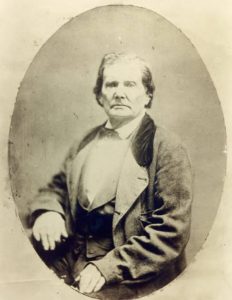 Abraham Lincoln’s father, Thomas Lincoln, died on January 17, 1851, at the ripe old age of 73. Abraham opted not to travel to see his father in his waning days, in part because they were no longer close, but also because Lincoln’s third son, Willie, had been born about a month before and his wife, Mary, was exhibiting significant post=partum sickness. I visited the Lincoln homestead and gravesite near Lerna, Illinois, a few years ago in order to learn more about Thomas and wrote about it here. While they may have had a difficult relationship, Thomas actually had taught Lincoln about farming science as he grew up.
Abraham Lincoln’s father, Thomas Lincoln, died on January 17, 1851, at the ripe old age of 73. Abraham opted not to travel to see his father in his waning days, in part because they were no longer close, but also because Lincoln’s third son, Willie, had been born about a month before and his wife, Mary, was exhibiting significant post=partum sickness. I visited the Lincoln homestead and gravesite near Lerna, Illinois, a few years ago in order to learn more about Thomas and wrote about it here. While they may have had a difficult relationship, Thomas actually had taught Lincoln about farming science as he grew up.






 Even when I’m trying to reduce the number of books in my house I end up with more. My Abraham Lincoln book acquisition total for 2022 is 34, and that number includes some books that are Lincoln-ish. You can read about past years acquisitions by
Even when I’m trying to reduce the number of books in my house I end up with more. My Abraham Lincoln book acquisition total for 2022 is 34, and that number includes some books that are Lincoln-ish. You can read about past years acquisitions by 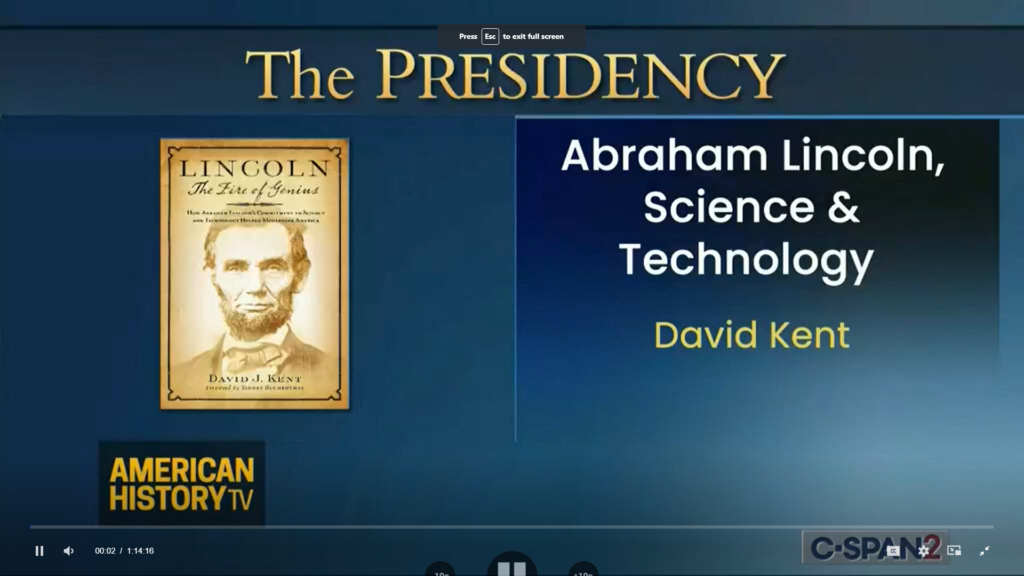
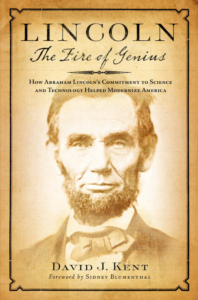
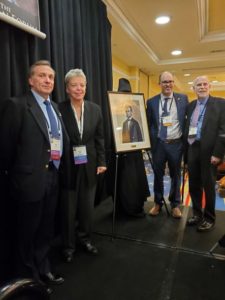 Let’s start with the award. As president of the
Let’s start with the award. As president of the  I also led a breakout session about my book. About thirty people gathered to discuss Lincoln’s interests in science and technology. Joining me was Ed Steers. Like me, Ed had a full career as a scientist (he was at the National Institutes of Health) before turning to Lincoln scholarship. He is a renowned expert on Lincoln’s assassination as well as his early life and ancestry. Questions from the participants led us into discussions not only about my book, but also the broader issues of how scientific and historical research are similar and dissimilar, a topic I wrote about back in June in a post called “
I also led a breakout session about my book. About thirty people gathered to discuss Lincoln’s interests in science and technology. Joining me was Ed Steers. Like me, Ed had a full career as a scientist (he was at the National Institutes of Health) before turning to Lincoln scholarship. He is a renowned expert on Lincoln’s assassination as well as his early life and ancestry. Questions from the participants led us into discussions not only about my book, but also the broader issues of how scientific and historical research are similar and dissimilar, a topic I wrote about back in June in a post called “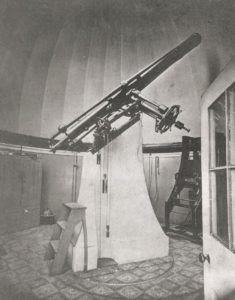 Abraham Lincoln was fascinated by science. One particular fascination was astronomy. Lincoln had attained some knowledge of basic astronomy in Indiana. By his seventeenth year, he had reached his adult six-foot-four-inch height, his 160 pounds glued to a taut muscular frame. Awkward in movement and dress, the uniqueness of his mind managed to impress at least some of the girls. One fifteen-year-old, Anna “Kate” Roby, found him more scientifically instructive than romantic as they sat on the banks of the Ohio River. After Roby noted in awe that the moon was going down, Lincoln lapsed into a rather clinical discourse on the nature of planetary movement: “That’s not so,” he said, “it don’t really go down; It seems so.” He went on to explain: “The Earth turns from west to East and the revolution of the Earth carries us under, as it were: we do the sinking as you call it. The moon as to us is comparatively still. The moons sinking is only an appearance.” Notwithstanding the rudimentary nature of this description, Roby concluded that “Abe knew the general laws of astronomy and the movements of the heavenly bodies,” which she attributed to him being better read than anyone else in the region—“a learned boy among us unlearned folks.” What he read to gain this knowledge is unknown, but Roby admitted that “No man could talk to me that night as he did unless he had known something of geography as well as astronomy.” At least one early researcher suggested Lincoln had access in Indiana to John O’Neill’s New and Easy System of Geography and Popular Astronomy. The book provides a basic introduction to geographical terms and how to read maps, plus an extensive history of each continent. This is followed by an extensive discussion of popular astronomy, the basics of the earth and moon’s movement, the causes of solar and lunar eclipses, and explanations of comets, meteors, and constellations. There are even chapters on the moon’s effect on tides, calculations of longitude, and weather prediction.
Abraham Lincoln was fascinated by science. One particular fascination was astronomy. Lincoln had attained some knowledge of basic astronomy in Indiana. By his seventeenth year, he had reached his adult six-foot-four-inch height, his 160 pounds glued to a taut muscular frame. Awkward in movement and dress, the uniqueness of his mind managed to impress at least some of the girls. One fifteen-year-old, Anna “Kate” Roby, found him more scientifically instructive than romantic as they sat on the banks of the Ohio River. After Roby noted in awe that the moon was going down, Lincoln lapsed into a rather clinical discourse on the nature of planetary movement: “That’s not so,” he said, “it don’t really go down; It seems so.” He went on to explain: “The Earth turns from west to East and the revolution of the Earth carries us under, as it were: we do the sinking as you call it. The moon as to us is comparatively still. The moons sinking is only an appearance.” Notwithstanding the rudimentary nature of this description, Roby concluded that “Abe knew the general laws of astronomy and the movements of the heavenly bodies,” which she attributed to him being better read than anyone else in the region—“a learned boy among us unlearned folks.” What he read to gain this knowledge is unknown, but Roby admitted that “No man could talk to me that night as he did unless he had known something of geography as well as astronomy.” At least one early researcher suggested Lincoln had access in Indiana to John O’Neill’s New and Easy System of Geography and Popular Astronomy. The book provides a basic introduction to geographical terms and how to read maps, plus an extensive history of each continent. This is followed by an extensive discussion of popular astronomy, the basics of the earth and moon’s movement, the causes of solar and lunar eclipses, and explanations of comets, meteors, and constellations. There are even chapters on the moon’s effect on tides, calculations of longitude, and weather prediction.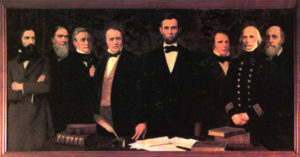 Abraham Lincoln is well known as having interests in science, but he also had an interest in the arts. Join me at the Arts Club of Washington on October 26th to explore the arts and sciences of Abraham Lincoln. The event is open to the public.
Abraham Lincoln is well known as having interests in science, but he also had an interest in the arts. Join me at the Arts Club of Washington on October 26th to explore the arts and sciences of Abraham Lincoln. The event is open to the public.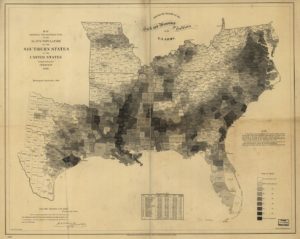 Lincoln took a scientific approach to military strategy. The Anaconda plan’s focus was on securing the coastlines and the Mississippi River. Recognizing New Orleans as the hub of the cotton trade and commerce, Lincoln saw it as the first port to be targeted for blockade. He also hoped to block southern ship traffic from Charleston, South Carolina to cut off Confederate attempts to woo Great Britain and France to their side. Helping him make this happen was Alexander Dallas Bache and the Coast Survey. The Coast Survey had been authorized by Thomas Jefferson, and Bache, who was Benjamin Franklin’s great-grandson, was quick to send nautical charts of the Chesapeake Bay to Lincoln. He also forwarded two terrestrial maps produced by the Survey that had far-reaching influence on Lincoln’s decisions on emancipation and military strategy.
Lincoln took a scientific approach to military strategy. The Anaconda plan’s focus was on securing the coastlines and the Mississippi River. Recognizing New Orleans as the hub of the cotton trade and commerce, Lincoln saw it as the first port to be targeted for blockade. He also hoped to block southern ship traffic from Charleston, South Carolina to cut off Confederate attempts to woo Great Britain and France to their side. Helping him make this happen was Alexander Dallas Bache and the Coast Survey. The Coast Survey had been authorized by Thomas Jefferson, and Bache, who was Benjamin Franklin’s great-grandson, was quick to send nautical charts of the Chesapeake Bay to Lincoln. He also forwarded two terrestrial maps produced by the Survey that had far-reaching influence on Lincoln’s decisions on emancipation and military strategy.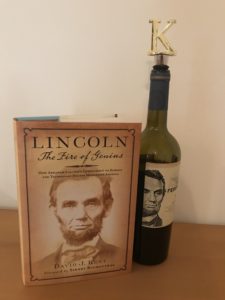 I was interviewed for the summer 2022 issue of The Lincolnian, the newsletter of the Lincoln Group of DC. This is Part 3, the final part. Here is
I was interviewed for the summer 2022 issue of The Lincolnian, the newsletter of the Lincoln Group of DC. This is Part 3, the final part. Here is 






